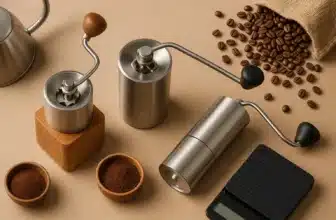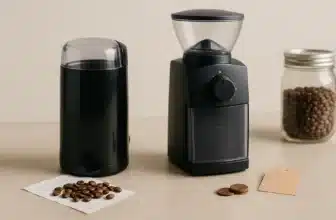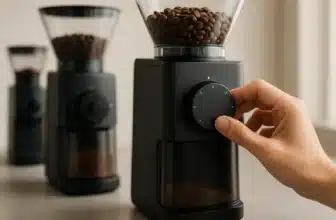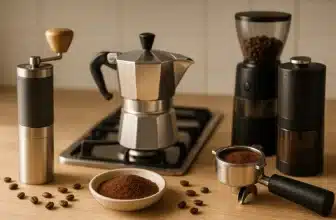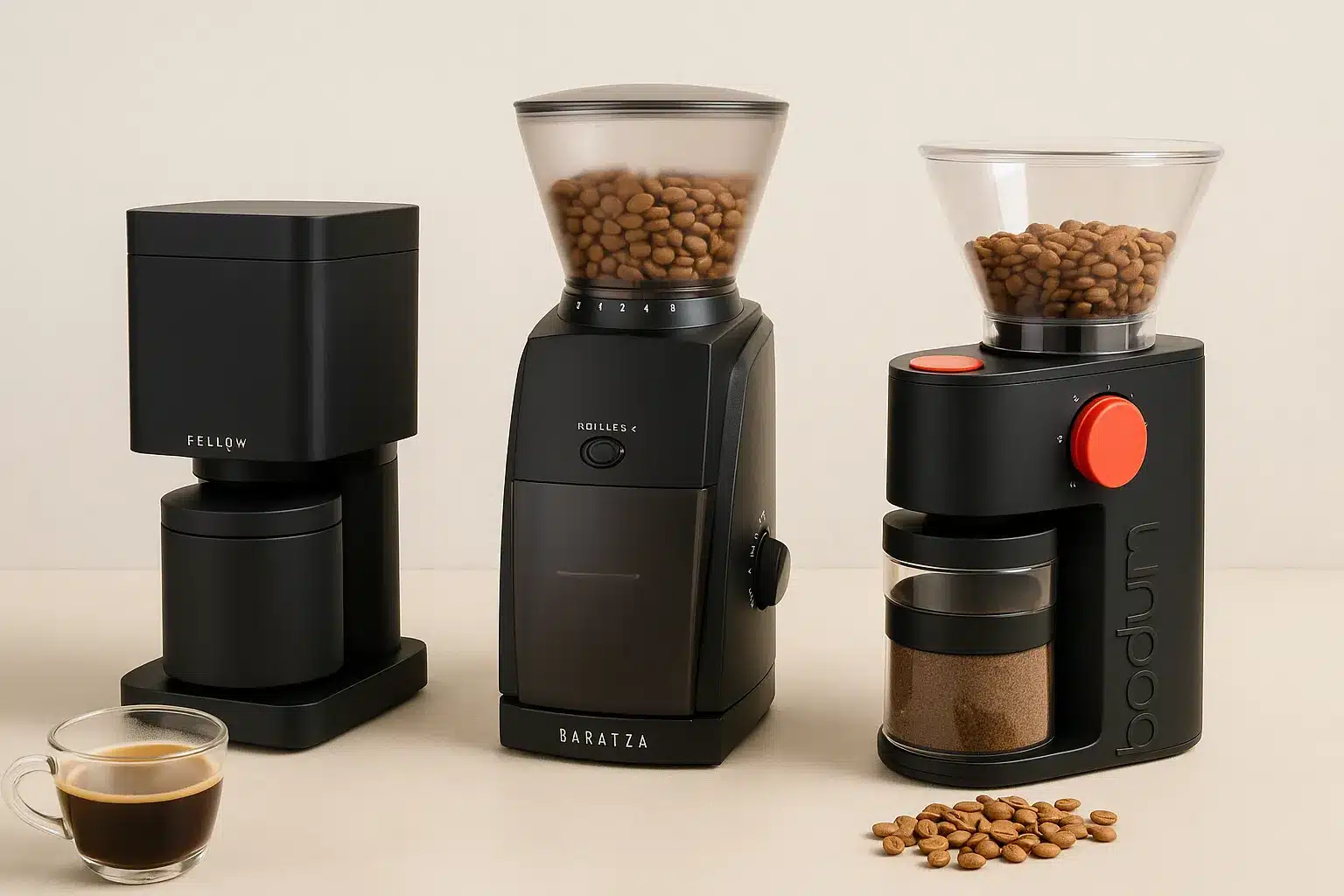
OneHundredCoffee is reader-supported, and some products displayed may earn us an affiliate commission. Details
Light roasts are the bright, zesty, fruit-forward side of coffee—the kind that surprises you with bergamot, stone-fruit, and floral notes you didn’t realize beans could carry. However, those lively flavors only emerge when your grinder is up to the task. Light-roast beans are denser and more resistant to breaking apart, and they are far less forgiving of uneven grind sizes. If your grinder creates a lot of boulders and fines, you’ll either under-extract (flat, sour) or over-extract (dry, bitter), and miss the magic entirely.
We’ve spent months dialing in light roasts on drip machines, V60s, Aeropress, espresso machines, and French presses. Our team tests for clarity in the cup, sweetness, balance, and how easily a grinder lets you repeat a great result. We pay close attention to burr geometry, adjustment range, heat buildup during grinding, retention, static, and daily workflow quirks—because a grinder can be technically “good,” but still fussy in a morning rush.
Below you’ll find five grinders we think cover a spectrum of needs and budgets, each with a unique angle on light-roast performance:
- Gevi Conical Burr Coffee Grinder (35 settings): an approachable burr grinder for drip and pour-over folks who want a solid upgrade from blades.
- Mr. Coffee 12-Cup Electric Grinder (Multi-Settings): a low-cost, compact blade grinder for casual brewers who prioritize convenience.
- DR MILLS DM-7441W Electric Dried Spice & Coffee Grinder: a tough, multitasking blade unit that doubles as a spice grinder and handles small, fresh doses.
- KINGrinder (Manual Series): a hand grinder family (e.g., K-series) that punches way above its price for pour-over clarity and travel-friendly precision.
- Gaggia MDF 55 Espresso & Coffee Grinder: a robust flat-burr workhorse aimed at espresso precision and low-drama daily use.
A Quick View of The Best Coffee Grinders for Light Roast Beans
| Image | Product | Features | Price |
|---|---|---|---|
Best Multi-Setting Burr Grinder  |
| Price on Amazon | |
Best Simple Blade Grinder  | Price on Amazon | ||
Best Small Electric Grinder  |
| Price on Amazon | |
Best Manual Precision Grinder  |
| Price on Amazon | |
Classic Espresso Grinder 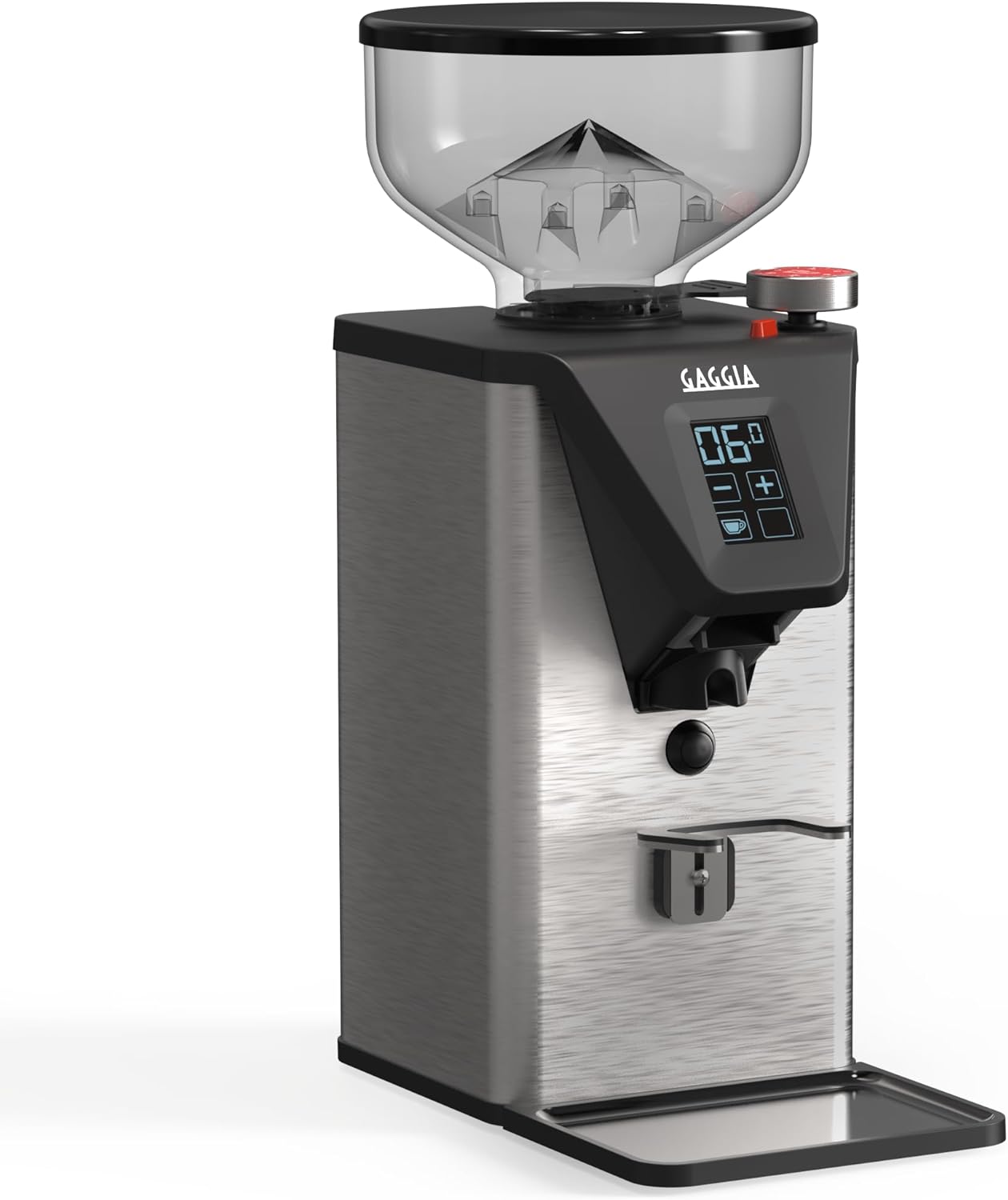 |
| Price on Amazon |
We’ll walk you through detailed, real-world impressions of each, then share a comparison table and a buyer’s guide tailored to light roast success.
How We Test Light Roast Grinders (and Why It Matters)
Light roasts make your grinder show its true colors. We test each grinder through:
- Brew method range: V60 (02), Kalita 155/185, Aeropress (inverted & regular), drip machine, French press, and, if applicable, espresso.
- Consistency checks: sieve spot-checks, side-by-side cuppings, and back-to-back brews to evaluate repeatability and drift.
- Workflow and cleanup: single-dose friendliness, static, retention, re-dosing accuracy, and how quickly you can go from “beans in” to “brew on.”
- Heat management: especially important for light roasts that need longer grind times or finer settings; we watch for flavor dulling or scorched aromas.
- Dial-in speed: Can we land a sweet, clear cup in 1–2 tries? Or are we burning through beans to find a working setting?
Gevi Conical Burr Coffee Grinder (Adjustable Burr Mill with 35 Precise Grind Settings)

Gevi Conical Burr Coffee Grinder — 51 Settings (Anti-static)
Key Features
- 51 precise grind settings from espresso to French press
- Stainless steel conical burrs for uniform particle size
- Anti-static grounds bin reduces clinging mess
- Timed grinding for up to 10 cups
- Compact design with easy-to-clean removable parts
Why We Like It
This Gevi grinder offers surprising versatility for its size and price, delivering consistent grinds with minimal static. Great for anyone brewing multiple styles at home.
Pros
- Wide grind range with 51 steps
- Effective anti-static design
- Good balance of price and performance
- Compact, kitchen-friendly footprint
Cons
- Not fully stepless for ultra-precise dialing
- More retention than high-end grinders
Bottom Line
A versatile and affordable grinder with fine control and less static—an excellent daily driver for espresso to pour-over.
Price on AmazonIf you’re stepping up from a blade grinder and dreaming of clean, balanced light-roast pour-overs, the Gevi with 35 stepped settings is a reasonable entry point. Its conical burrs produce a more uniform particle size than blades, which immediately helps clarity. For daily drip and V60 brewing, we found the mid-range settings deliver cups that highlight lemon zest, florals, and gentle sweetness without veering into sharp acidity.
Grind quality & range: The 35 steps cover coarse French press down to a medium-fine suitable for many pour-overs and some moka pots. For espresso, it’s not the target tool—light-roast espresso wants ultra-fine control and micro-steps that the Gevi can’t consistently deliver. But for filter brewing, it’s a win: fewer boulders than blades and fewer fines than bargain burrs. The result is cups with more definition and less muddiness.
Heat, static, and retention: Conical burrs at this level don’t run excessively hot in typical home doses (15–30 g). We still recommend the Ross Droplet Technique (RDT)—a light mist on beans to reduce static and keep chaff from clinging to the chute. Retention is modest; a quick tap post-grind lowers leftover grounds.
Workflow: The dial-based adjustment is intuitive. Stepped systems make it easy to mark your favorite setting for a specific light roast and come back later. The hopper holds enough for multi-cup mornings, though we still prefer single dosing (weighing beans per brew) for light roasts to avoid staling and improve repeatability.
Cup profile with light roasts: Expect better separation of tasting notes versus blades—citrus and florals stand apart from the sweetness instead of blurring together. On brighter Ethiopian or Kenyan beans, you’ll get more sparkle and a cleaner finish, provided your water and recipe are on point.
Build & cleaning: Routine brushing keeps it tidy; a monthly deeper clean helps maintain consistency. Plastic elements keep costs down, but the burrs do the heavy lifting where it counts.
Verdict: For filter coffee fans, the Gevi is a sensible upgrade that reveals what your light roasts actually taste like. It’s not an espresso specialist, but as a daily driver for V60, drip, and Aeropress, it’s a strong value with genuine flavor gains.
Best for: Light-roast pour-over and drip lovers upgrading from blades and wanting a straightforward, repeatable workflow.
Mr. Coffee 12-Cup Electric Coffee Grinder (Multi Settings)

Mr. Coffee Electric Coffee Grinder (Black)
Key Features
- Blade grinder design for quick grinding
- Grinds up to 12 cups of coffee at once
- Transparent lid for grind monitoring
- Simple one-touch operation
- Compact size for easy storage
Why We Like It
A straightforward, affordable grinder for drip coffee and everyday brewing. Easy to use, easy to clean, and reliable for basic coffee prep.
Pros
- Very affordable price
- Compact and lightweight
- Grinds enough for a full pot of coffee
- Simple push-button use
Cons
- Less consistent than burr grinders
- No grind size adjustment
Bottom Line
A great entry-level grinder if you just want fresh coffee grounds quickly without spending much.
Price on AmazonHere’s our detailed review. The Mr. Coffee 12-Cup is a blade grinder with simple cup markings and multiple time-based settings. It’s compact, budget-friendly, and genuinely convenient when you just want coffee without a ritual. If your priority is speed and price, this is the easy button. For light roasts, the trade-off is consistency: blades chop rather than crush, so you get a wide particle spread.
Grind quality reality check: Can you make a tasty light-roast cup with a blade grinder? Yes—with care. Pulse in short bursts, shake the unit between pulses to redistribute beans, and stop before the fines overwhelm the batch. If you brew with a coarser-tolerant method (French press, Clever Dripper, metal-filter drip), you can land surprisingly pleasant cups. Expect less clarity and more body; some delicate notes will blur, and you might need to adjust brew ratios (try 1:15 instead of 1:16–1:17) and water temperature (go a touch hotter) to avoid flatness.
Why some folks still like it: For casual coffee drinkers, the Mr. Coffee 12-Cup is low-maintenance and small-space friendly. The “cups” guide helps approximate batch sizes quickly. It’s also a quiet, low-stress way to grind at 6 a.m. without waking the house.
Light-roast tips for blades:
- Pulse and shake: aim for shorter pulses and frequent redistributions.
- RDT: A drop or two of water on beans greatly reduces static.
- Slightly longer brew: compensate for boulders by extending contact time a touch.
- Paper filters: they catch fines better and tidy up the cup.
Flavor expectations: You’ll get the general character of the bean—citrus, floral, or cocoa—but less sparkle and separation than burr grinders. For everyday coffee, this can be “good enough.” For showcasing delicate light roasts, burrs will do better.
Verdict: The Mr. Coffee 12-Cup wins on simplicity and cost. It’s a practical, entry-level choice for people who want coffee fast and aren’t chasing the last 10% of light-roast clarity. If you later fall in love with pour-overs, you’ll likely upgrade to burrs—but this is a fine first step.
Best for: Budget-minded brewers who value ease and compactness over precision, and who primarily use French press, drip with paper, or immersion methods.
DR MILLS DM-7441W Electric Dried Spice & Coffee Grinder

DR MILLS DM-7441 Electric Coffee & Spice Grinder
Key Features
- Electric blade grinder suitable for coffee, nuts, and spices
- 150W motor with stainless-steel cup and blade
- Up to 12-cup coffee capacity per grind
- Transparent lid for grind control
- Safety switch — works only with lid locked
Why We Like It
A compact and versatile kitchen grinder that doubles for coffee and spices. Simple one-touch control makes it easy to operate while the stainless-steel cup ensures durability.
Pros
- Multi-purpose (coffee + spices + nuts)
- Durable stainless-steel construction
- Safety lid lock design
- Compact and easy to store
Cons
- Blade grinder less consistent than burrs
- No preset grind settings
Bottom Line
A reliable little workhorse for those who want a budget-friendly, multi-purpose electric grinder for daily coffee and spice use.
Price on AmazonHere’s our detailed review. Another blade-style option, the DR MILLS DM-7441W is built like a little tank with a sturdy stainless-steel grinding chamber and a powerful motor that’s equally at home with spices. If you batch-grind cardamom and peppercorns, then rinse the chamber (or keep a second unit just for coffee), this grinder’s durability stands out.
What we liked for light roasts: The DM-7441W handles small, fresh doses very well—10–20 g single doses let you pulse more precisely and minimize heat. With careful technique (short pulses, redistributing between pulses), you can nudge the particle distribution toward a coarser, more even profile that suits Aeropress and drip better than many budget blades.
Why spice-capable matters: Light roasts are aromatic and can pick up on smells from stale spice residue. The DM-7441W’s stainless chamber cleans up quickly, and it doesn’t retain odors the way some plastics do. If you love cooking as much as coffee, it’s a handy multipurpose tool.
Cup profile: Expect rounded brightness and solid sweetness, especially on washed light roasts. You won’t get the crystalline separation of a good burr set, but you can pull a pleasing, balanced cup with a slightly longer brew and a paper filter. We also liked this grinder for cold brew with light roasts—the coarse, bouldery output actually works in your favor for that method, yielding high clarity after filtration.
Workflow tips:
- Single dose to keep heat and retention low.
- RDT for static control.
- Clean frequently if you also grind spices (or dedicate a bowl for coffee).
- Aeropress shines here—two-minute steep, gentle press, and a paper filter keep fines in check.
Verdict: The DM-7441W is a durable, versatile blade grinder with better-than-expected performance in small doses for light roasts. It’s still a blade, so expectations should be pragmatic—but as a compact, tough little unit, it earns its keep.
Best for: Home cooks who want a multi-purpose grinder and coffee drinkers brewing Aeropress, drip, or cold brew with light roasts.
KINGrinder (Manual Series)

KINGrinder Manual Coffee Grinder (Straight Handle)
Key Features
- High-precision stainless steel burrs for uniform grinding
- Straight handle design for ergonomic grinding motion
- Adjustable grind settings for espresso, pour-over, and French press
- Durable all-metal construction for long-term use
- Compact, travel-friendly design
Why We Like It
KINGrinder has built a reputation for precise, smooth, and consistent grinding. The straight handle design makes manual grinding easier while retaining fine control over your grind size.
Pros
- Excellent consistency across grind settings
- Durable stainless steel burr set
- Portable, lightweight, and travel-ready
- Ergonomic design reduces fatigue
Cons
- Manual effort required for larger doses
- More expensive than entry-level hand grinders
Bottom Line
A top-tier manual burr grinder built for precision and durability—ideal for espresso lovers and travelers who demand consistency in every cup.
Price on AmazonThe KINGrinder family (e.g., K-series models) has built a passionate following for delivering manual precision at an approachable price. For light roasts, a well-aligned manual with sharp steel burrs is often a revelation: less heat, tight particle control, and the ability to move in tiny clicks for exacting pour-over or even home espresso on forgiving baskets.
Grind quality & light-roast clarity: This is where KINGrinder shines. The cup profile on a V60 or flat-bottom dripper is sparkling and layered—think citrus oils, white-peach sweetness, and jasmine-like aromatics—because the grind distribution tends to be tighter than entry-level electrics. Fine control means you can compensate for bean density and roast variance easily: one click finer to tame a zippy Kenyan, one click coarser to open up sweetness on an Ethiopian.
Manual effort: With light roasts, expect a bit more resistance when grinding fine. For pour-over and Aeropress, it’s smooth and quick. For espresso-fine, you’ll feel the workout; some models add a better handle and bearings to help. If you regularly make multiple back-to-back espresso shots, you may want an electric. For single cups, the manual ritual is surprisingly pleasant.
Workflow perks:
- Single-dosing by design—weigh beans, grind, brew.
- Zero-to-near-zero retention, excellent for freshness and consistency.
- Travel-ready: toss it in your bag, grind on-site, and get café-quality pour-overs anywhere.
- Alignment: many owners value that KINGrinders can be well-aligned out of the box; periodic checks keep performance peak.
Flavor outcomes: Expect high clarity and sweetness with light roasts, often outclassing budget electrics. For espresso, you can get there with patience, but the real sweet spot is filter brewing, where you’ll taste the upgrades immediately.
Verdict: If your heart belongs to light-roast pour-overs, KINGrinder is the value sweet spot. It unlocks the crisp, dimensional flavors you bought those beans for—without the price of a premium electric.
Best for: Enthusiasts who prioritize clarity and control in pour-over, Aeropress, and travel setups; occasional light-roast espresso tinkerers.
Gaggia MDF 55 Espresso & Coffee Grinder

Gaggia MDF Espresso & Coffee Grinder
Key Features
- Commercial-grade 50 mm flat burrs for uniform grinding
- Multiple grind settings for espresso to drip coffee
- Precision dosing system with manual operation
- Sturdy build designed for daily espresso use
- Compact footprint fits easily on kitchen counters
Why We Like It
The Gaggia MDF brings barista-level consistency into the home. With durable flat burrs and espresso-focused grind control, it’s a dependable partner for semi-automatic machines.
Pros
- Commercial-quality burrs for precise grinds
- Reliable espresso-focused consistency
- Durable build and long-lasting performance
- Simple manual controls
Cons
- Louder than some conical burr grinders
- Less versatile for ultra-coarse methods (cold brew)
Bottom Line
A classic grinder tailored for espresso enthusiasts—precise, durable, and compact enough for everyday use at home.
Price on AmazonHere’s our detailed review. The Gaggia MDF 55 is built to make espresso simple, repeatable, and delicious—especially with demanding light roasts. With flat burrs around 55 mm and a sturdy build, it focuses on uniformity and low drift day-to-day, the kind of stability you want when dialing in a dense, Scandinavian-leaning roast.
Why flat burrs help light-roast espresso: Flat burr geometry tends to emphasize sweetness and structure with a more unimodal distribution than bargain conicals. For light roasts, that can mean tighter dialing windows, more tactile syrupiness, and shots that bloom into lemon curd, florals, and stone-fruit rather than skittering into sharp acidity.
Adjustment & workflow: Depending on the specific variant, you’ll see stepped or micro-stepped adjustment. Either way, the steps are fine enough to land workable espresso settings on light roasts, and repeatability is excellent. The chute is efficient, retention is modest, and it’s happy single-dosed if you prefer freshness over a full hopper. It’s not a featherweight, but the heft speaks to motor stability and long-term reliability.
Cup profile: On a 1:2 or 1:2.2 ratio with a 25–35 s window, we consistently found juicy shots with well-integrated brightness and a clean finish. The MDF 55 also does well at moka pot and fine-drip settings, though its true home is espresso. If you’re chasing café-grade light-roast shots, this grinder makes the process surprisingly approachable.
Noise & maintenance: Quieter than many home grinders in its class, with straightforward cleaning. Keep burrs brushed, run an occasional grind cleaner, and you’ll maintain performance for years. If you’re pulling multiple shots daily, consider a monthly deep clean.
Verdict: The Gaggia MDF 55 is a reliable flat-burr specialist that loves light-roast espresso. If your daily routine revolves around dialing in dense beans and you want fewer variables, this is a satisfying anchor for your espresso bar.
Best for: Home baristas who prioritize light-roast espresso with repeatability and café-like texture.
Side-by-Side Comparison (Light-Roast Performance)
| Grinder | Burr/Blade | Manual/Electric | Best Use Cases | Light-Roast Strengths | Light-Roast Limitations | Noise | Price Tier | Who It’s For |
|---|---|---|---|---|---|---|---|---|
| Gevi Conical Burr (35 settings) | Conical burr | Electric | Drip, V60, Aeropress | Cleaner cups, easy repeatability, solid value | Lacks micro-steps for light-roast espresso | Moderate | Budget-Mid | Brewer moving up from blades |
| Mr. Coffee 12-Cup (Multi Settings) | Blade | Electric | French press, immersion, basic drip | Fast, compact, simple | Wide particle spread; delicate notes blur | Low-Moderate | Budget | Casual coffee drinker |
| DR MILLS DM-7441W | Blade | Electric | Aeropress, drip, cold brew, spices | Durable chamber, great for small doses, easy cleanup | Still a blade; needs technique | Moderate | Budget | Cook + coffee fan, multi-use |
| KINGrinder (Manual Series) | Steel burr | Manual | V60, flat-bottom drippers, Aeropress, travel | High clarity, tight control, low retention | Manual effort; espresso is possible but slower | Very low | Budget-Mid | Light-roast pour-over enthusiast |
| Gaggia MDF 55 | Flat burr (~55 mm) | Electric | Espresso (light roasts), moka, fine drip | Sweet, structured shots, repeatable dialing | Bigger/heavier; overkill for casual drip | Moderate | Mid-Premium | Home barista focused on espresso |
Buyer’s Guide: Choosing a Grinder for Light Roast Beans
1) Burr type & geometry
- Flat burrs often deliver structured sweetness and excellent espresso control—great for dense light roasts that need tight dialing.
- Conical burrs can excel for drip and pour-over, offering gentle body and clarity at affordable prices.
- Blades can work—if you understand their limits and pick brew methods that tolerate particle spread.
2) Adjustment resolution
Light roasts demand fine control. For espresso, micro-steps or stepless adjusters are ideal. For pour-over, smaller steps still matter—tiny tweaks can turn “lemon pith” into “lemon curd.”
3) Heat & speed
High motor speeds can build heat and dull nuance. Manual grinders and efficient electrics reduce heat and protect aromatics. Single dosing helps, too.
4) Retention & static
The less coffee left behind, the more consistent your next cup. Look for designs with low retention and use RDT to tame static—especially with light roasts that carry more chaff.
5) Daily workflow
If mornings are hectic, choose quick, intuitive adjustments and simple cleaning. If you enjoy the ritual, a manual grinder rewards you with control and portability.
6) Your primary brew method
- Espresso (light roasts): Aim for a flat-burr or high-precision conical with micro-adjustment (e.g., Gaggia MDF 55).
- Pour-over & drip: Conical burr electrics (Gevi) or manuals (KINGrinder) shine.
- Immersion & cold brew: Blades can be serviceable with technique; burrs still improve clarity.
7) Budget planning
Grinders last for years. If you love light roasts, it’s worth investing a bit more in burr quality and adjustment—you’ll taste the difference every morning.
Practical Tips for Brewing Light Roasts (Fast Wins)
- Use hotter water: 94–97 °C (201–207 °F) often helps extract sweetness from dense light roasts.
- Brew ratio tweaks: Try 1:15 or 1:16 for pour-over; for espresso, start around 1:2 and adjust.
- Rinse paper filters thoroughly to remove paper taste and improve clarity.
- Burr seasoning & cleaning: A few seasoning doses plus regular cleaning stabilize performance.
- RDT & WDT: A drop of water on beans (RDT) reduces static; Weiss Distribution Technique (WDT) for espresso evens out puck density and cuts channeling—vital for light roasts.
- Grind adjustments in tiny steps: Light roasts are sensitive; a single click can transform the cup.
Which Grinder Should You Buy?
- “I brew pour-overs and want better clarity without spending big.”
Go Gevi Conical Burr (35 settings). It’s the straightforward upgrade your V60 deserves. - “I just need coffee. Cheap, compact, and easy.”
Choose the Mr. Coffee 12-Cup. Use paper filters and the pulse-and-shake method for best results. - “I cook a lot and want one grinder for spices and coffee.”
DR MILLS DM-7441W delivers durability and dual-purpose practicality. - “I love light-roast pour-overs and don’t mind manual grinding.”
KINGrinder is your clarity machine—travel-ready and wonderfully precise. - “I’m chasing café-quality light-roast espresso at home.”
Gaggia MDF 55 offers the flat-burr control and repeatability you’ll appreciate every single day.
Personal Opinion
If I had to pick one grinder for light-roast pour-overs, I’d grab the KINGrinder. The clarity jump is instantly noticeable, and the tactile, quiet workflow is oddly relaxing. For light-roast espresso, the Gaggia MDF 55 is my no-nonsense recommendation—it tames the tight dialing windows of dense beans and consistently lands sweet, structured shots. If you’re stepping up from blades and want a budget electric for drip, the Gevi is the happiest middle ground.
Final Conclusion
Light roasts are where a grinder proves its worth. They ask for precision, consistency, and a workflow you’ll actually use every morning. Whether you prefer a manual path to sparkling pour-overs (KINGrinder), a flat-burr route to honey-sweet, citrus-bright espresso (Gaggia MDF 55), or a budget burr that immediately upgrades your drip game (Gevi), there’s a right-fit option here. Blades like Mr. Coffee 12-Cup and DR MILLS DM-7441W can absolutely produce enjoyable coffee with care—especially for immersion and cold brew—but if your goal is to unlock the ethereal nuance of light roasts, burrs are the surest road.



